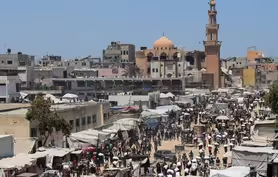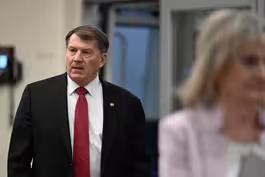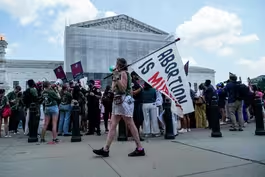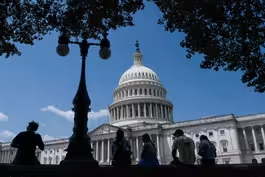
Analyzing Iran nuclear damage with former arms inspector
Clip: 6/26/2025 | 7m 31sVideo has Closed Captions
Iran's nuclear program ruined for now, deal needed to keep it that way, ex-inspector warns
The Trump administration again furiously defended the airstrikes against Iran's nuclear program, claiming the facilities were destroyed. Defense Secretary Hegseth denounced reporting on a leaked initial intelligence assessment that said Iran’s nuclear program was set back by only a few months. The leak of the report is being investigated by the FBI. Amna Nawaz discussed more with David Albright.
Problems playing video? | Closed Captioning Feedback
Problems playing video? | Closed Captioning Feedback
Major corporate funding for the PBS News Hour is provided by BDO, BNSF, Consumer Cellular, American Cruise Lines, and Raymond James. Funding for the PBS NewsHour Weekend is provided by...

Analyzing Iran nuclear damage with former arms inspector
Clip: 6/26/2025 | 7m 31sVideo has Closed Captions
The Trump administration again furiously defended the airstrikes against Iran's nuclear program, claiming the facilities were destroyed. Defense Secretary Hegseth denounced reporting on a leaked initial intelligence assessment that said Iran’s nuclear program was set back by only a few months. The leak of the report is being investigated by the FBI. Amna Nawaz discussed more with David Albright.
Problems playing video? | Closed Captioning Feedback
How to Watch PBS News Hour
PBS News Hour is available to stream on pbs.org and the free PBS App, available on iPhone, Apple TV, Android TV, Android smartphones, Amazon Fire TV, Amazon Fire Tablet, Roku, Samsung Smart TV, and Vizio.
Providing Support for PBS.org
Learn Moreabout PBS online sponsorshipGEOFF BENNETT: Welcome to the "News Hour."
The Trump administration today again furiously defended the U.S. airstrikes against Iran's nuclear program, claiming the facilities were destroyed.
It comes in response to a leaked initial intelligence assessment that said Iran's nuclear program was set back by only a few months.
That leak is now being investigated by the FBI.
AMNA NAWAZ: The report was produced by the Defense Intelligence Agency, or DIA.
But the director of the CIA issued a statement last night contradicting its finding.
At an early morning briefing today, Defense Secretary Pete Hegseth denounced the news media for its coverage of the report.
PETE HEGSETH, U.S. Defense Secretary: Because of decisive military action, President Trump created the conditions to end the war, decimating, choose your word, obliterating, destroying Iran's nuclear capabilities.
Every outlet has breathlessly reported on a preliminary assessment from DIA a day-and-a-half after the actual strike, when it admits itself in writing that it requires weeks to accumulate the necessary data to make such an assessment.
It's preliminary.
It points out that it's not been coordinated with the intelligence community at all.
There's low confidence in this particular report.
There's -- it says in the report there are gaps in the information.
GEOFF BENNETT: The chairman of the Joint Chiefs of Staff, General Dan Caine, showed a video of the testing of the kind of bomb that was used on Fordow and one other Iranian nuclear site to show the kind of damage it can do.
Meantime, Iran's supreme leader played down the impact of the U.S.-Israeli bombings on Iran's nuclear sites.
AYATOLLAH ALI KHAMENEI, Supreme Leader of Iran (through translator): They attacked our nuclear facilities, but they were not able to achieve anything significant.
The president of the United States made an unusual exaggeration in describing what had happened.
It became clear that he needed this exaggeration.
Anyone who heard those words understood that beneath the surface of those remarks there was another underlying truth.
They couldn't achieve their intended goal.
AMNA NAWAZ: For perspective on all this, we now turn to David Albright.
He's the founder and president of the Institute for Science and International Security.
He's also the co-author of the book "Iran's Perilous Pursuit of Nuclear Weapons."
David, welcome back.
Thanks for being here.
DAVID ALBRIGHT, President, Institute for Science and International Security: Good to be here.
AMNA NAWAZ: So, after the U.S. bombing, you issued a report in which you said this.
You said: "Israel's and the U.S. attacks have effectively destroyed Iran's centrifuge enrichment program.
It'll be a long time before Iran comes anywhere near the capability it had before the attack."
So does that mean you agree with the secretary of defense's assessment that the program was completely destroyed?
DAVID ALBRIGHT: Well, I think what we saw in satellite imagery, and we know a lot about the nuclear sites, is, you had thousands and thousands of centrifuges destroyed.
And, more importantly, you have the ability to make them was destroyed and to create the thing that's enriched.
There's a -- you put in uranium in a centrifuge, and it's a form of uranium hexafluoride.
The plant to do that is large, complicated, and it was destroyed.
And so, in that sense, they can't make any more centrifuges.
And once they run out of a supply of uranium hexafluoride, they can't run the centrifuges.
So, but, that being said, they also have these stocks of 60 percent in rich uranium.
They may have some centrifuges that have been made or manufactured, but not deployed in the two centrifuge plants, Natanz and Fordow, that were attacked.
AMNA NAWAZ: So what does all of this mean for that initial assessment that was leaked and reported on from the Defense Intelligence Agency that said the program was only set back a few months, not destroyed?
How should people make sense of those two?
DAVID ALBRIGHT: Yes, I think it's -- it was a report that the secretary or the chairman said was, should we strike again?
Did we get enough?
And so it's a worst-case assessment to try to decide if there should be another one.
And I think the leadership had decided, no, we have done enough.
It needs to be fleshed out with new information.
AMNA NAWAZ: So let's look a little deeper into the report you issued, because you include satellite photos.
They show the Fordow mountain, the holes in the ground where the American bunker-buster bombs struck, right where the ventilation shafts were located.
You have another image that you overlay over that appears to be a floor plan from inside the facility.
Just explain to us what we're seeing here and why this is significant.
DAVID ALBRIGHT: We lined up with the tunnel entrances.
And then in the floor plan, there's a ventilation system.
And we lined it up and we looked at imagery, and this goes back several years, and we could see the ventilation system being built in the mountain and then covered up.
And so we felt that that was a shaft that went from the mountain top right down to the plant and was a vulnerability.
AMNA NAWAZ: And that tells you that those strikes were successful?
DAVID ALBRIGHT: I mean, it tells us that I would expect them to be successful because they weren't boring through a mountain.
They were going down air in a shaft.
AMNA NAWAZ: You also include satellite photos that show the damage to another nuclear site, this one at Isfahan, that was targeted both by Israel and by the U.S. with cruise missiles.
What does this tell us about how damaged the facility was and how much it sets back Iran?
DAVID ALBRIGHT: Yes, and Israel attacked it twice.
And the United States attacked it once.
And so there was tremendous amount of damage there.
And some of the buildings held in the past 60 percent enriched uranium and 20 percent enriched uranium.
And then and that was clearly a target.
AMNA NAWAZ: And so is there an assessment on how far back the program is set?
Months?
Years?
DAVID ALBRIGHT: Well, it can take them years to rebuild these facilities.
I mean, I hate to put a year on it, a year, but it's not going to happen any time soon.
AMNA NAWAZ: David, there's also the question of whether or not some of the highly enriched uranium could have been moved from these sites in advance of the U.S. strikes.
We know the secretary of defense has said there's no evidence of that.
Is there any way to know that?
And if it was true and uranium was moved, what does that mean?
DAVID ALBRIGHT: Well, the Iranians said to the International Atomic Energy and see that they were planning to move it before the attack.
And in Isfahan, one of the buildings that historically held 60 percent and 20 percent was hit once, and then but not building wasn't destroyed.
Israel came back a couple of days later and did much more damage.
But that -- you would expect that buildings hit lightly,in a sense, they're going to move the enriched uranium out, just as a matter of course.
So I think we cannot ignore the existence of these stocks not being destroyed.
This issue has to be addressed, because the 60 percent can be turned into weapon-grade uranium quickly.
And we don't want to have to face this kind of potential threat six months a year, two years from now, whenever Iran may decide to try to break out again and make nuclear weapons.
AMNA NAWAZ: But, so, David, if some of those stockpiles either survived underground, can be recovered or removed, doesn't that undermine the argument that the program was completely destroyed?
DAVID ALBRIGHT: I interpret these things as political statements.
But I think, in this case, they have to make sure they're not blinding themselves, that they don't think they don't need a deal, because that's really -- you can solve this problem very directly with a nuclear deal with Iran that -- and you can be tough.
We want those stocks removed from Iran.
And we want to go back, we want to go back, U.S. contractors go back and drill into Fordow and find that - - those canisters under the rubble.
AMNA NAWAZ: David Albright, always great to have you and your expertise and insights on the show.
Thank you so much.
Ex-surgeon general on vaccine panel overhauled by RFK Jr.
Video has Closed Captions
Clip: 6/26/2025 | 7m 9s | Trump's former surgeon general raises concerns about vaccine panel overhauled by RFK Jr. (7m 9s)
Ksenia Karelina describes life after release from Russia
Video has Closed Captions
Clip: 6/26/2025 | 9m 43s | Ksenia Karelina says release from Russian prison 'feels like starting a new life' (9m 43s)
News Wrap: At least 18 killed in Gaza strike, hospital says
Video has Closed Captions
Clip: 6/26/2025 | 3m 39s | News Wrap: At least 18 killed as they waited for flour, Gaza hospital officials say (3m 39s)
Remembering acclaimed public TV journalist Bill Moyers
Video has Closed Captions
Clip: 6/26/2025 | 5m 56s | Remembering acclaimed public TV journalist Bill Moyers (5m 56s)
Sen. Rounds says Iran nuclear threat 'seriously eliminated'
Video has Closed Captions
Clip: 6/26/2025 | 6m 45s | GOP Sen. Rounds says Iran nuclear threat 'very seriously eliminated' (6m 45s)
Supreme Court ruling allows states to deny Medicaid funds
Video has Closed Captions
Clip: 6/26/2025 | 6m | Supreme Court clears way for states to deny Medicaid funding for Planned Parenthood (6m)
Who gains and who loses under Trump’s big budget bill
Video has Closed Captions
Clip: 6/26/2025 | 5m 14s | Who gains and who loses under Trump’s big budget bill (5m 14s)
Providing Support for PBS.org
Learn Moreabout PBS online sponsorshipSupport for PBS provided by:
Major corporate funding for the PBS News Hour is provided by BDO, BNSF, Consumer Cellular, American Cruise Lines, and Raymond James. Funding for the PBS NewsHour Weekend is provided by...


















